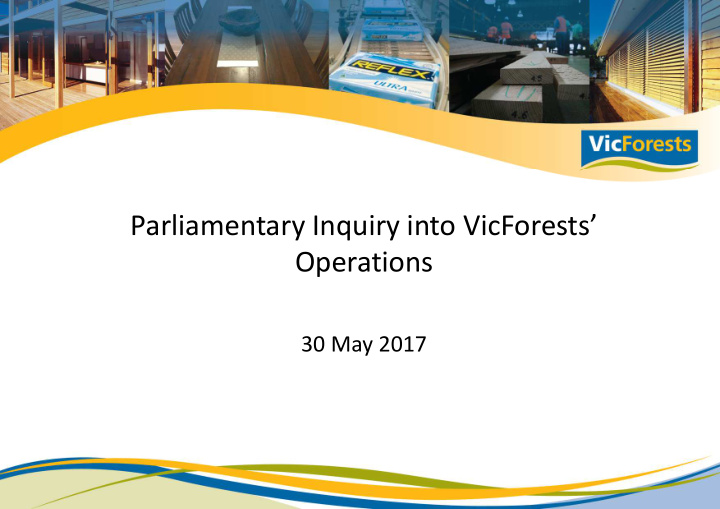



Parliamentary Inquiry into VicForests’ Operations 30 May 2017
About VicForests State Owned Corporation • – Independent Board – Responsible to the Minister for Agriculture and Treasurer – Activities regulated by the Department of Environment, Land, Water and Planning Responsible for the sustainable harvest and commercial sale • of timber from Victoria’s native forests Required to operate sustainably, be commercially prudent • and consider long-term economic returns to the State Responsible for ensuring all areas harvested • are successfully regenerated
VicForests’ Core Business Determine the quantity, quality and location of timber • that can be sustainably harvested Allocate timber in a competitive market • Plan harvesting activities and develop timber delivery • schedules Engage forest contracting businesses to harvest the timber • and deliver it to our customers Regenerate all harvested areas •
What we do Australia’s largest supplier of high • quality hardwood sawlogs $112 million in timber sales in 2015-16 • 110-120 VicForests staff • Family owned, local contractor • companies – harvest, haul, road maintenance, seed picking Mainly Victorian-based customers in primary • manufacturing Contribute to State’s bushfire fighting as part • of Forest Fire Management Victoria
Why we do it – demand for timber products
Legislative Framework and Regulatory overview
Timber Supply Modelling Highly variable and fragmented forest • Enormous amount of data • Very complex modelling • Multiple scenarios analysed and tested • Aim to optimise availability, sales and • supply commitments, economics and sustainability
Timber Allocation and Sales Range of allocation processes used to maximise • commercial and economic return to the State Balance need for certainty (industry) with • supply risks (VicForests) and economic return Allocation processes open and competitive • Aim to allocate all products off harvested areas • Timber sold in advance of harvest •
Harvest Planning Harvest on a 60 – 120 year rotation • Every area assessed prior to harvest and a detailed coupe plan prepared • Considers a range of factors to protect values such as: • - streams - wildlife habitat - steep slopes
Harvesting Coupe marking to protect trees/other values • Majority of harvesting done mechanically - increase in efficiency/safety • High-value sawlogs graded • Each operation produces a range of products which are distributed to multiple customers •
How our timber is used Not all parts of the tree are the same! •
Regeneration Locally picked seed is used to ensure the same species regrow on each site • Regeneration burns assists the natural regeneration process that Victoria’s forest have evolved to • cope with Approximately 600 million individual seeds spread by helicopter annually as part of VicForests’ • regeneration program
Economic contribution Sold more than $1.1 billion worth • of timber since 2004 A significant component of revenue is injected • into regional Victoria through contract payments and wages Central Highlands industry generates annual • revenue of $570 million and 2100 direct jobs “VicForests has demonstrated that it balances the need to operate profitably with the need to support industry and socio-economic sustainability” “VicForests does not receive any government subsidies” - Victorian Auditor General’s Office Report 2013
Recommend
More recommend